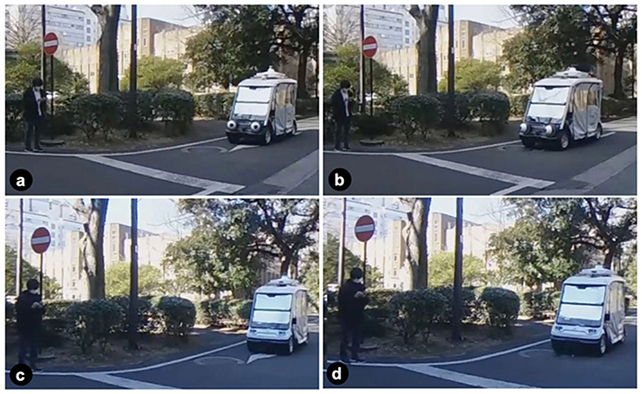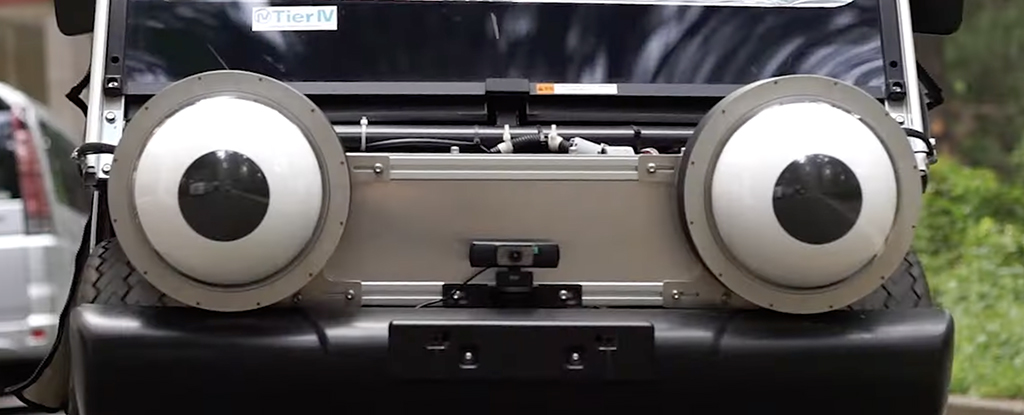Products You May Like
In one of the more unusual experiments we’ve seen recently, researchers attached a large pair of cartoonish googly eyes to the front of a small, self-driving vehicle – and it turns out that this kind of anthropomorphic tweak could actually improve pedestrian safety.
A roving pair of peepers on the front of driverless vehicles could, according to the researchers, give people standing by the road a better idea of whether they’ve been seen. That’s one useful bit of information to have when it comes to determining the perfect moment to cross in front of oncoming traffic.
“If the car is not looking at the pedestrian, this implies that the car does not recognize the pedestrian,” write the researchers. “Thus, pedestrians can judge that they should not cross the street, thereby avoiding potential traffic accidents.”
Based on the research, this sort of ‘gazing car’ has the potential to cut down on the number of traffic accidents, as well as helping pedestrians feel safer.
For the purposes of this study the researchers used a golf buggy rigged to appear as if no one was inside. A pair of large, swiveling eyes on the front were controlled by researchers, but in the future could be controlled by the car’s AI on an actual self-driving vehicle.
To keep the 18 participants safe, experiments were conducted in virtual reality. The volunteers – nine men and nine women – were asked to decide whether or not to cross the road as the cart approached. Four scenarios were tested in total; two when the cart was fitted with eyes, and two when it wasn’t.
The researchers measured how often people hesitated to cross when it was in fact safe to do so, and how often they opted to cross when it was dangerous. Overall, the presence of the eyes led to safer and smoother crossing experiences for the participants.

However, there was a gender split in the results. For men, the eyes only really helped in dangerous situations, warning them to pause when they might otherwise proceed. For women, the eyes boosted confidence by signaling it was safe to cross.
“The results suggested a clear difference between genders, which was very surprising and unexpected,” says one of the researchers, Chia-Ming Chang from the University of Tokyo in Japan.
“While other factors like age and background might have also influenced the participants’ reactions, we believe this is an important point, as it shows that different road users may have different behaviors and needs, that require different communication ways in our future self-driving world.”
A self-driving world may look significantly different in all kinds of ways. Both passengers inside autonomous vehicles and other road users around them are going to have to recalibrate their behavior in certain respects.
While oversized cartoon eyes won’t necessarily be adopted as a future feature of autonomous vehicles, the study is a good example of the type of research that’s needed to better understand how pedestrians and autonomous cars interact before they hit the road.
Ultimately the aim is to keep everyone as safe as possible, if and when autonomous driving becomes the norm. At the moment, it seems that’s a long way off yet – giving scientists more time to look at the resulting implications.
“There is not enough investigation into the interaction between self-driving cars and the people around them, such as pedestrians,” says computer scientist Takeo Igarashi, from the University of Tokyo.
“So, we need more investigation and effort into such interaction to bring safety and assurance to society regarding self-driving cars.”
A paper on the research was presented ahead of peer review at the International Conference on Automotive User Interfaces and Interactive Vehicular Applications.
